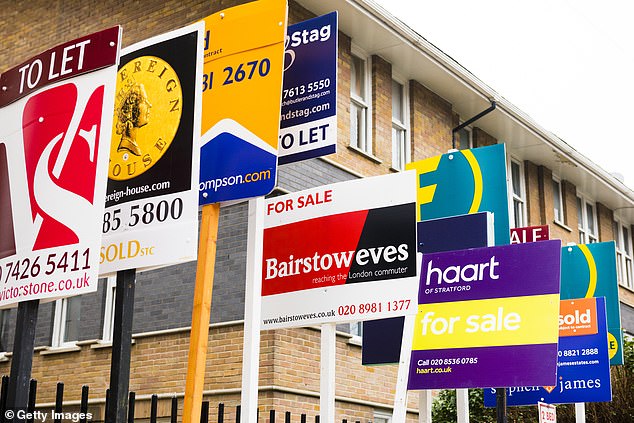Mortgages are finally getting cheaper – but should you wait for things to get better? Here’s what top experts say
Mortgage holders struggling with high borrowing costs are finally seeing light at the end of the tunnel after lenders cut interest rates last week.
The Bank of England’s base rate cut to 5 percent has prompted a fresh round of cuts by major mortgage lenders, offering fresh hope to the 700,000 homeowners with fixed-rate contracts expiring in the second half of the year.
But will interest rates fall quickly enough to make a real difference to your monthly repayments? And if you’re nearing the end of your term, should you wait for further reductions?
What happens to the mortgage interest rate?
Homeowners have been struggling with high borrowing costs as rising rates added hundreds to monthly repayments. But we appear to have reached a turning point. Within hours of the Bank of England’s base rate cut, major lenders including Santander and Coventry Building Society repriced tracker and variable mortgages by 0.25 percentage points from September, while Barclays cut its tracker rates.
Fixed interest rates fell in the run-up to the rate cut, as lenders lowered lending rates in anticipation.
Ranald Mitchell of Charwin Mortgages expects the cuts to accelerate in the coming weeks. He says: ‘Mortgage lenders are starting to bring interest rates down.’
But because the Bank’s cut came earlier than many expected, lenders are likely to continue cutting rates, said David Hollingworth of broker L&C. Building societies Skipton, Leeds and Yorkshire announced further cuts, as did NatWest.
The average two-year fixed-rate mortgage rate was 5.76 percent on Friday, while the average five-year rate was 5.37 percent, according to rate checkers Moneyfactscompare.
This is down from 5.97 percent on June 28 for the average two-year fixed term, while the percentage for five-year contracts was 5.55 percent.
You need to repair now or hold fire?
Fixed rate deals are likely to continue to improve. Ranald Mitchell, of Charwin Mortgages, expects the pace of cuts to accelerate in the coming weeks. He says: ‘Mortgage lenders are starting to cut interest rates.’
Markets expect the Bank of England to cut interest rates once more before the end of the year.
Brokers say the best rates in early 2025 could be almost two percentage points lower than the current average. Nicholas Mendes, a broker at John Charcol, says borrowers with a loan-to-value ratio of 60 percent should be able to get a five-year fix for just 3.5 percent in early 2025. Mortgage holders with a loan-to-value ratio of 80 percent could get rates of around 4 percent.
But what if you want to refinance your mortgage now?
Tracker mortgages have benefited most directly from the Bank’s interest rate cut, as they are directly linked to the base rate.
According to banking industry body UK Finance, borrowers with a tracker mortgage are expected to see their bills fall by an average of £336 a year.
It may be tempting to take out a tracker mortgage and wait for fixed rates to fall further. But this strategy could cost you dearly, as tracker deals are expensive, says Justin Moy of EHF Mortgages. He says there is typically a 0.5 to 1 percentage point gap between two-year fixed rates and two-year tracker deals, with tracker deals being the higher of the two.

It can be tempting to take out a tracker mortgage and wait for fixed rates to fall further. But this strategy could cost you dearly, as tracker deals are expensive, says Justin Moy of EHF Mortgages.
Borrowers would therefore need another two to four base rate cuts on tracker deals to equalise current fixed-rate products.
Mr Moy says: ‘Tracker mortgages are expensive, so it’s hard to justify taking one out just to save money.’
He says people can get a better deal through their lender. Some banks and building societies even offer a ‘track and switch’ product, so homeowners can take out a tracker deal and then switch when interest rates fall in 2025.
For homeowners who value certainty in their monthly repayments, fixed-term deals are often a good option, says Craig Fish of Lodestone Mortgages. Rolling over to a standard variable rate (SVR) to wait for further rate cuts can also prove costly.
According to Moneyfactscompare, the average SVR on August 1 was 8.16 percent.
Even if the fixed rate were to fall by 0.5 percentage points over the next six months, you could still be worse off if you wait. A homeowner with a £150,000, 25-year mortgage who sits on an 8.49 per cent SVR for six months and then switches to a 4.35 per cent fixed rate product in six months’ time would spend £22,098 on their mortgage over two years, according to broker L&C.
The same borrower taking a 4.85 per cent two-year fix now would pay £20,732 over two years – £1,366 less. This assumes the SVR does not fall.
How long do you have to be locked up?
Borrowers who want more certainty about monthly repayments tend to fix their loans for longer, says Ben Perks of Orchard Financial Advisers.
‘Some borrowers are being forced to borrow because of the new affordability calculations, which mean that you have to borrow more if you fix the mortgage for a longer period.’
He has seen that more and more people are taking out a shorter, higher fixed-interest period in the hope of getting a better interest rate in a few years.
Choose a broker who will review your choices until the refinancing is completed.
Some links in this article may be affiliate links. If you click on them, we may earn a small commission. That helps us fund This Is Money and keep it free. We do not write articles to promote products. We do not allow commercial relationships to influence our editorial independence.
